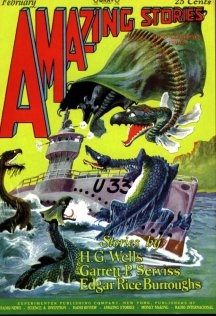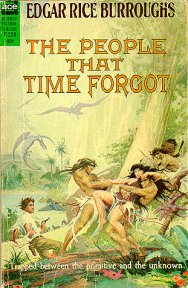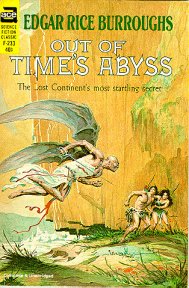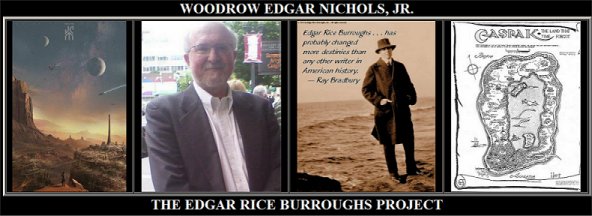.

ERB'S EMBRYONIC JOURNEY:
THE TRIMESTERS OF CASPAK
Part One
by
Woodrow Edgar Nichols, Jr.
(Dedicated to George McWhorter)

.
“It must have been a little after three o’clock in
the afternoon that it happened – the afternoon of June 3rd, 1916. It seems
incredible that all that I have passed through – all those weird and terrifying
experiences – should have been encompassed within so short a span as three
brief months. Rather might I have experienced a cosmic cycle, with all
its changes and evolutions for that which I have seen with my own eyes
in this brief interval of time – things that no other mortal eye had seen
before, glimpses of a world past, a world dead, a world so long dead that
even in the lowest Cambrian stratrum no trace of it remains. Fused with
the melting inner crust, it has passed forever beyond the ken of man other
than in that lost pocket of the earth whither fate has borne me and where
my doom is sealed. I am here and here must remain.” (LTF/1.)
Those are the opening lines of The Land that Time Forgot,
the title of the first book of the trilogy as well as the Caspakian Trilogy
as a whole. The other two books in the Trilogy are The People that Time
Forgot and Out of Time’s Abyss. These three books form the three
trimesters of revelation about Caspakian evolution that the overall work
offers the reader. Moreover, this trilogy comprises most of the published
work of ERB during 1917 – the year the USA entered the First World War.
It is safe to assume, from the dates that appear in the story itself (see
above), that ERB began writing the first book on June 3, 1916.
At the ERBzine C.H.A.S.E.R site (ERBzine
# 0766), it is boldly stated that ERB began writing the trilogy in
September 1917, with a working title for the first book, “The Lost U-boat,”
which makes sense, seeing that most of the time the story takes place on
board the U-33. This means the USA was already actively involved in WWI
when ERB began writing, making the series all the more war propaganda.
It is stated that he began writing the third book of the trilogy, Out of
Time’s Abyss, in May 1918, six months before the conclusion of WWI. So
there was never a time ERB was writing this trilogy that the USA was not
at war with Germany. Who says a double negative can’t sound right?
Although it is true that David Bruce Bozarth (“Tangor”) and Rick Johnson
have covered Caspak in detail (see, “Caspak: The Land that Time Forgot”;
“A Caspak Glossary”; and “Caspak is an Enigma”; at www.erblist.com/erbmania/caspak),
I may still have a thing or two to add. (See, also, the insightful “Caspak
in Review,” by Steve Servello, ERBzine
#2120, as well as the many 25 ERBzine references below.) First and
foremost is the very strange way ERB has gone about in the telling of the
story.
It begins with the viewpoint of the first person lines quoted above,
which are allegedly from a journal written by Bowen J. Tyler, Jr., discovered
some time later in a bottle that washed ashore in Greenland. The finder
of the bottle and journal, an “unidentified narrator” (Bozarth identifies
him as ERB, but we will call him U.N. from now on for the reasons stated
below). The U.N. then picks up the story, also in the first person, narrating
how he found the bottle with its long message. Then – hold on to your hats!
– the story again shifts back to Bowen Tyler’s point of view, who, in the
journal, finishes the story begun above, ending with his signature, as
well as that of his common law wife’s. And that’s just for the first trimester.
In fact, except for the last book of the trilogy, which is told in the
third person – primarily from Bradley’s point of view – the first two books,
regardless of the narrator, are told in the first person.
The second book begins again in the first person, told from the point
of view of the U.N., who tells the story of how he and Tom Billings, the
assistant secretary of Bowen Tyler, Sr., organized a relief mission to
rescue Tyler, Jr. and whoever else survived their ill-fated voyage to Caspak.
That narration comes to a sudden end at the end of Chapter One when Billings
disappears in his airplane over the forbidding outward cliffs of the island
Caprona, into the forbidding interior of Caspak. Chapter Two then shifts
quite abruptly without notice to the first person narration of Billings,
who finishes the story. In fact the shift is so abrupt, it takes a second
to realize that someone else other than the U.N. is narrating.
As mentioned, the third story is told entirely in the omniscient third
person, but we can assume that the U.N. is telling the story for the sake
of continuity. Structurally, as a whole, the narration of the Caspakian
Trilogy appears as thus:
1) Bowen Tyler (in the first person from his journal);
2) The U.N. (in the first person);
3) Bowen Tyler (in the first person from his journal);
4) The U.N. (in the first person);
5) Billings (an abrupt shift, in the first person);
6) The U.N. (an assumption; told in the third person from Bradley’s
point of view).
As can be seen, this is a very complex, and sometimes confusing, narrative
structure. Either ERB was experimenting, or having fun, or both. Anyway,
it is not half as interesting as the story itself.
I have no dispute with Mr. Bozarth over the identity of the U.N. I mean,
after all, since ERB wrote the story it is a logical assumption that he
expected his readers to believe that was the U.N. As we know from the Barsoomian
Mythos, it was not uncommon for ERB to give fake backgrounds to his story
were he was a major character. (See, “The Epiphanies of John Carter and
the Fake Autobiographies of ERB,” ERBzine
3908 and ERBzine 3311.)
What is different, however, between the Barsoomian Mythos and the Caspakian
Trilogy, is that in the Mythos, ERB identifies himself specifically as
John Carter’s nephew. In contrast, there is no way of positively identifying
the U.N. in the Trilogy by any other information than that which is given...which,
as we shall see, is bleak.
A. The Unidentified Narrator (U.N.)
This is the man who finds the journal hidden in the bottle. His purpose,
of course, is to establish a foundation for the suspension of disbelief
to follow. ERB had a lot of fun with how this story is told, for the personalities
of Tyler, Billings, and Bradley differ widely. Tyler is an idiot when it
comes to trusting blood-thirsty, double-dealing, back-stabbing Prussian
nobility, who has a very non-John Carter defeatist philosophy of life.
Billlings is more worldly, but his weakness for adventure and discovery,
like that of Tarzan’s in Tarzan at the Earth's Core, is reckless
and puts everyone’s hope of rescue in dire peril. And last of all, Bradley
is the utmost pragmatist, whose running joke line is the conservation of
ammunition. From all these different points of view, Caspak is revealed,
much as the life of Jesus must be pieced together from the biased and heavily
redacted sources which make up the New Testament.
I will now quote from the Trilogy what material there is about the U.N.,
and then you can compare for yourself that material with that of what we
know about the real life of ERB. After the quote above from Tyler’s message
in a bottle, the U.N. then begins his account of finding the manuscript:
“After reading this far, my interest,
which already had been stimulated by the finding of the manuscript, was
approaching the boiling-point. I had come to Greenland for the summer,
on the advice of my physician, and was slowly being bored to extinction,
as I had thoughtlessly neglected to bring sufficient readingmatter. Being
an indifferent fisherman, my enthusiasm for this form of sport soon waned;
yet in the absence of other forms of recreation I was now risking my life
in an entirely inadequate boat off Cape Farewell at the southernmost extremity
of Greenland.” (The Land that Time Forgot, Chapter One [LTF/1].)
I don’t believe the real ERB ever traveled to Greenland on the advice of
a doctor. Thus, in my opinion, the narrator is a fictional character created
to achieve the purpose of giving the story an element of pseudo-historical
truth, since the story itself is so fantastic. The U.N. is thus the bridge
between the writer and the reader, the trusted charlatan that guides the
reader’s imagination into realms of wonder. Remember, in 1917 many places
in the world were still unexplored and full of mystery; the reading public
fantasized about lost continents and peoples and openings at the poles
into a hollow earth, and were open to suspending their disbelief in these
matters, as modern audiences are willing to do so with UFO’s, Ancient Astronauts,
and the Bermuda Triangle. The U.N. continues:
“Greenland! As a descriptive appellation,
it is a sorry joke – but my story had nothing to do with Greenland, nothing
to do with me; so I shall get through with the one and the other as rapidly
as possible.” (LTF/1.)
The reader can immediately perceive how effective this technique is. The
fact that the U.N. gives us information about Greenland, and then tells
us to forget it lends credibility to the narration and adds excitement,
mystery, and adventure to what is to come.
“The inadequate boat finally arrived at a precarious landing, the natives,
waist-deep in the surf, assisting. I was carried ashore, and while the
evening meal was being prepared, I wandered to and fro along the rocky,
shattered shore. Bits of surf-harried beach clove the worn granite, or
whatever the rocks of Cape Farewell may be composed of, and as I followed
the ebbing tide down one of these soft stretches, I saw the thing. Were
one to bump into a Bengal tiger in the ravine behind the Bimini Baths,
one could be no more surprised than I was to see a perfectly good quart
thermos bottle turning and twisting in the surf of Cape Farewell at the
southern extremity of Greenland. I rescued it, but I was soaked above the
knees doing it; and then I sat down in the sand and opened it, and in the
long twilight read the manuscript, neatly written and tightly folded, which
was its contents.
“You have read the opening paragraph,
and if you are an imaginative idiot like myself, you will want to read
the rest of it; so I shall give it to you here, omitting quotation marks
– which are difficult of remembrance. In two minutes you will forget me.”
(LTF/1.)
Being ignorant of the Bimini Baths, I Googled it and discovered that the
baths were a popular Los Angeles destination between 1900 and 1950, especially
for the Hollywood crowd. Not only ERB, but stars like Douglas Fairbanks
and Charlie Chaplin used to frolic in the thermal hot springs that bubbled
up freely under the baths. Information from the Bresee Foundation, which
currently controls the property, states:
“It was first built in 1900 by Dr. David Edwards who decided
to take advantage of the natural hot springs that still exist in the ground
beneath the street today. Five years later, this original wooden structure
burned to the ground.... It was rebuilt more magnificent than before, with
hot and cold water pools, an upper floor gymnasium, café, game room
and lots more. The H street car brought tourists from downtown Los Angeles
to Bimini. Hollywood movie stars stayed in the apartment buildings and
the grand hotel across the street (all of which are still there!), and
kids took their first plunge in a pool at Bimini as there were few private
and no public swimming pools in Los Angeles at the time.” (www.bresee.org/biministories.)
I surmised that ERB must have known this place intimately since he refers
to the ravine behind it. He probably used the baths on one of his visits
to Los Angeles during this period.
Anyway, the reference to the baths gives another element of credibility
to the story, which now shifts back to the manuscript and Tyler’s narration.
We don’t hear from our U.N. again until the first chapter of The
People that Time Forgot, where he first relates how, after reading
Tyler’s manuscript, he delivered it to Tyler’s father in Santa Monica,
California.
“I am forced to admit that even though
I had traveled a long distance to place Bowen Tyler’s manuscript in the
hands of his father, I was still a trifle skeptical as to its sincerity
since Bowen had been one of the most notorious practical jokers of his
alma mater. The truth was that as I sat in the Tyler library in Santa Monica
I commenced to feel a trifle foolish and to wish that I had merely forwarded
the manuscript by express instead of bearing it personally, for I confess
that I do not enjoy being laughed at. I have a well-developed sense of
humor – when the joke is not on me.
“Mr. Tyler, Sr., was expected almost hourly.
The last steamer in from Honolulu had brought information of the date of
the expected sailing of his yacht Toreador, which was now twenty-four hours
overdue. Mr. Tyler’s assistant secretary, who had been left at home, assured
me that there was no doubt but that the Toreador had sailed as promised,
since he knew his employer well enough to be positive that nothing short
of an act of God would prevent his doing what he had planned to do. I was
also aware of the fact that the sending apparatus of the Toreador’s wireless
equipment was sealed, and that it would only be used in event of dire necessity.
There was, therefore, nothing to do but wait, and we waited.
“We discussed the manuscript and hazarded guesses
concerning it and the strange events it narrated. The torpedoing of the
liner upon which Bowen J. Tyler, Jr., had taken passage for France to join
the American Ambulance was a well-known fact, and I had further substantiated
by wire to the New York office of the owners, that a Miss La Rue had been
booked for passage. Further, neither she no Bowen had been mentioned among
the list of survivors; nor had the body of either of them been recovered.
“Their rescue by the English tug was entirely
probable; the capture of the enemy U-33 by the tug’s crew was not beyond
the range of possibility; and their adventures during the perilous cruise
which the treachery and deceit of Benson extended until they found themselves
in the waters of the far South Pacific with depleted stores and poisoned
water-casks, while bordering upon the fantastic, appeared logical enough
as narrated, event by event, in the manuscript.” (PTF/1.)
Again, ERB is having fun. Note how he addresses any reader who may have
doubted the credibility of the first book of the Trilogy.
ERB is making sure that reader understands that his crazy story is half-way
believed by the U.N. and Tyler’s assistant. After all, they give logical
reasons for their belief and once again this proves a neat method for establishing
in the second book another round of readers’ suspension of disbelief.
As we discover, the island of Caprona and the land of Caspak are in
the South Pacific near Antarctica; whereas Greenland, where the thermos
bottle was found, is in the North Atlantic, a mighty long way for the bottle
to have traveled. One can imagine the bottle traveling via ocean currents
eastwards under South America, then northward, somehow getting into the
Gulf Stream, ultimately making landfall in Greenland. According to my World
Atlas, Cape Farewell is at the
southernmost tip of Greenland.
Anyway, ERB never gives us a time frame between the launching of the
bottle from the cliffs of Caspak and the U.N.’s discovery of the bottle
in the water’s of Cape Farewell. At the time of the discovery of the bottle,
it would appear from the actions of the Germans in the story, that WWI
was not yet over. Thus, we don’t really have any clue as to how much research
ERB did on this to give a satisfactory scientific basis for the journey
of the bottle, but it appears to me that it would have taken over a year
or more.
If I remember correctly, it only a took a few months in 1947 for Thor
Heyerdahl to sail on a balsawood raft from Peru to Tuomotu in the South
Pacific following ocean currents. But like I said, ERB doesn’t give us
a time frame for the U.N.’s narration in the second book, other than his
belief that Tyler was still alive and that they still had time to save
him if he was.
“Caprona has always been considered a
more or less mythical land, though it is vouched for by an eminent navigator
of the eighteenth century; but Bowen’s narrative made it seem very real,
however many miles of trackless ocean lay between us and it. Yes, that
narrative had us guessing. We were agreed that it was most improbable;
but neither of us could say that anything which it contained was beyond
the range of possibility. The weird flora and fauna of Caspak were as possible
under the thick, warm atmospheric conditions of the superheated crater
as they were in the Mesozoic era under almost exactly similar conditions,
which were then probably world-wide. The assistant secretary had heard
of Caprona and his discoveries, but admitted that he never had taken much
stock in the one nor the other. We were agreed that the one statement most
difficult of explanation was that which reported the entire absence of
human young among the various tribes with which Tyler had had intercourse.
This was the one irreconcilable statement of the manuscript. A world of
adults! It was impossible.” (PTF/1.)
This last fact is highlighted in the narration for it is the most important
clue which leads to the final revelation of Caspakian’s strange evolution,
an impossible evolution under the laws of evolution as we currently understand
them.
“We speculated on the possible fate of
Bradley and his party of English sailors. Tyler had found the graves of
two of them; how many more might have perished! And Miss La Rue – could
a young girl long have survived the horrors of Caspak after having been
separated from all of her own kind? The assistant secretary wondered if
Nobs still was with her, and then we both smiled at this tacit acceptance
of the truth of the whole uncanny tale.” (PTF/1.)
The astute reader will see the contradiction in this last bit of speculation,
for the end of the manuscript informs the reader that Miss La Rue was found
by Tyler before he cast the thermos off the cliff. After all, the manuscript
was cosigned by Miss La Rue, who signed it as “Lys La R. Tyler,” with a
tacit recognition of her common law marriage to Tyler. ERB usually had
so many stories going at the same time that it is no wonder that mistakes
like this were made.
“‘I suppose I’m a fool,’ remarked the
assistant secretary; ‘but by George, I can’t help believing it, and I can
see that girl now, with the big Airedale at her side protecting her from
the terrors of a million years ago. I can visualize the entire scene –
the apelike Grimaldi men huddled in their filthy caves; the huge pterodactyls
soaring through the heavy air upon their batlike wings; the mighty dinosaurs
moving their clumsy hulks beneath the dark shadows of preglacial forests
– the dragons which we considered myths until science taught us that they
were true recollections of the first man, handed down through countless
ages by word of mouth from father to son out of the same unrecorded dawn
of humanity.’
“‘It is stupendous – if true,’ I replied. ‘And
to think that possibly they are still there – Tyler and Miss La Rue – surrounded
by hideous dangers, and that possibly Bradley still lives, and some of
his party! I can’t help hoping all the time that Bowen and the girl have
found the others; the last that Bowen knew of them, there were six left,
all told – the mate Bradley, the engineer Olson, and Wilson, Whitely, Brady
and Sinclair. There might be some hope for them if they could join forces;
but separated, I’m afraid they couldn’t last long.’
“‘If only they hadn’t let the German prisoners
capture the U-33! Bowen should have had better judgment than to have trusted
them at all. The chances are von Schoenvorts succeeded in getting safely
back to Kiel and is strutting around with an Iron Cross this very minute.
With a large supply of oil from the wells they discovered in Caspak, with
plenty of water and ample provisions, there is no reason why they couldn’t
have negotiated the submerged tunnel beneath the barrier cliffs and made
good their escape.’” (PTF/1.)
From statements such as this, it seems safe to assume that WWI was still
going on as the U.N. and the assistant secretary further conversed. This
is important in the context of the story since it is basically disguised
war propaganda where Germans and war atrocities during the war went hand
in hand. ERB was a true patriot. Germany was one of his biggest markets
before the war, and he knew that writing these kinds of stories, where
the Germans were portrayed as monster sadists, would cost him most of that
audience, which it did:
“‘I don’t like ‘em,’ said the assistant
secretary; ‘but sometimes you got to hand it to ‘em.’
“‘Yes,’ I growled, ‘and there’s nothing I’d enjoy
more than handing it to them!’ And then the telephone-bell rang.
“The assistant secretary answered, and as I watched
him, I saw his jaw drop and his face go white. ‘My God!’ he exclaimed as
he hung up the receiver as one in a trance. ‘It can’t be!’
“‘What?’ I asked.
“‘Mr. Tyler is dead,’ he answered in a dull voice.
‘He died at sea, suddenly, yesterday.’
“The next ten days were occupied in burying Mr.
Bowen J. Tyler, Sr., and arranging plans for the succor of his son. Mr.
Tom Billings, the late Mr. Tyler’s secretary, did it all. He is force,
energy, initiative and good judgment combined and personified. I never
have beheld a more dynamic young man. He handled lawyers, courts and executors
as a sculptor handles his modeling clay. He formed, fashioned and forced
them to his will. He had been a classmate of Bowen Tyler at college, and
a fraternity brother, and before that he had been an impoverished and improvident
cow-puncher on one of the great Tyler ranches. Tyler, Sr., had picked him
out of the thousands of employees and made him; or rather Tyler had given
him an opportunity, and then Billings had made himself. Tyler, Jr., as
good a judge of men as his father, had taken him into his friendship, and
between the two of them they had turned out a man who would have died for
a Tyler as quickly as he would have for his flag. Yet there was none of
the sycophant or fawner in Billings; ordinarily I do not wax enthusiastic
about men, but this man Billings comes as close to my conception of what
a regular man should be as any I have ever met. I venture to say that before
Bowen J. Tyler sent him to college he had never heard the word ethics,
and yet I am equally sure that in all his life he never has transgressed
a single tenet of the code of ethics of an American
gentleman.” (PTF/1.)
Well, maybe this narrator is supposed to be a fake ERB after all, because
that sure sounds like him talking. In fact, of all the multiple narrators
in this story, Billings, even more than the U.N., is the most like ERB,
especially when he captures and tames a horse. Thinking about that right
now, I am leaning back to the narrator not being a fake ERB, but just an
unnamed tool of narration.
“Ten days after they brought Mr. Tyler’s
body off the Toreador, we steamed out into the Pacific in search of Caprona.
There were forty in the party, including the master and crew of the Toreador;
and Billings the indomitable was in command. We had a long and uninteresting
search for Caprona, for the old map upon which the assistant secretary
had finally located it was most inaccurate. When its grim walls finally
rose out of the ocean’s mists before us, we were so far south that it was
a question as to whether we were in the South Pacific or the Antarctic.
Bergs were numerous, and it was very cold.” (PTF/1.)
I must interrupt at this point to make an observation. In a typical ERB
adventure story, plans would have gone totally awry by this time, and the
rest of the story would be comprised of a series of adventures that had
absolutely nothing to do with their started goal. Then ERB would wrap up
the story in just a few pages at the end. Although this story is more focused
around Caspakian evolution, ERB essentially stays true to his writing method.
Bowen Tyler’s plans were to join the American Ambulance in France, yet
he wound up in Caspak. It was Tom Billings’ plan to fly to the top of the
cliffs so as to lower ropes down to the Toreador, yet he ended up exploring
the interior and crash landing after being attacked by a pterodactyl. Finally,
Bradley’s search party plans were foiled and he was unable to return to
Fort Dinosaur on time, losing one man to a Tyrannosaurus, and another to
a saber-tooth tiger. But ERB only allows the story to go according to plan
until it reaches Caspak. Then everything falls apart. No wonder the ERB
writing method drives most English Professors crazy.
This is a method that is impossible to teach. No wonder it is easier
to dismiss ERB as a hack pulp fiction writer who broke all the rules of
plotting rather than deal with him as a master of creativity with a unique
writing style that mesmerized the world stage of readers for decades.
“All during the trip Billings had steadfastly
evaded questions as to how we were to enter Caspak after we had found Caprona.
Bowen Tyler’s manuscript had made it perfectly evident to all that the
subterranean outlet of the Caspakian river was the only means of ingress
or egress to the crater world beyond the impregnable cliffs. Tyler’s party
had been able to navigate this channel because their craft had been a submarine,
but the Toreador could as easily have flown over the cliffs as sailed under
them. Jimmy Hollis and Colin Short whiled away many an hour inventing schemes
for surmounting the obstacle presented by the barrier cliffs, and making
ridiculous wagers as to which one Tom Billings had in mind; but immediately
we were all assured that we had raised Caprona, Billings called us together.
“‘There was no use talking about these things,’
he said, ‘until we found the island. At best it can be but conjecture on
our part until we have been able to scrutinize the coast closely. Each
of us has formed a mental picture of the Capronian seacoast from Bowen’s
manuscript, and it is not likely that any two of these pictures resemble
each other, or that any of them resemble the coast as we shall presently
find it. I have in view three plans for scaling the cliffs, and the means
for carrying out each is in the hold. There is an electric drill with plenty
of waterproof cable to reach from the ship’s dynamos to the cliff-top when
the Toreador is anchored at a safe distance from shore, and there is sufficient
halfinch iron rod to build a ladder from the base to the top of the cliff.
It would be a long, arduous and dangerous work to bore the holes and insert
the rungs of the ladder from the bottom upward; yet it can be done.
“‘I also have a life-saving mortar with which
we might be able to throw a line over the summit of the cliffs; but this
plan would necessitate one of us climbing to the top with the chances more
than even that the line would cut at the summit, or the hooks at the upper
end would slip.
“‘My third plan seems to me the most feasible.
You all saw the number of large, heavy boxes lowered into the hold before
we sailed. I know you did, because you asked me what they contained and
commented upon the large letter “H” which was painted upon each box. These
boxes contain the various parts of a hydro-aeroplane. I purpose assembling
this upon the strip of beach described in Bowen’s manuscript – the beach
where he found the dead body of the apelike man – provided there is sufficient
space above high water; otherwise we shall have to assemble it on deck
and lower it over the side. After it is assembled, I shall carry tackle
and ropes to the cliff-top, and then it will be comparatively simple to
hoist the search-party and its supplies in safety. Or I can make a sufficient
amount of trips to land the entire party in the valley beyond the barrier;
all will depend, of course, upon what my first reconnaissance reveals.’
“That afternoon we steamed slowly along the face
of Caprona’s towering barrier.
“‘You see now,’ remarked Billings as we craned
our necks to scan the summit thousands of feet above us, ‘how futile it
would have been to waste our time in working out details of a plan to surmount
those.’ And he jerked his thumb toward the cliffs. ‘It would take weeks,
possibly months, to construct a ladder to the top. I had no conception
of their formidable height. Our mortar would not carry a line halfway to
the crest of the lowest point. There is no use discussing any plan other
than the hydro-aeroplane. We’ll find the beach and get busy.’” (PTF/1.)
For all of Billings’ cool leadership and foresight, he is about to force
his crew to waste their time anyway working out details to surmount the
cliffs since he will soon be crashing the hydroplane in the Caspakian jungle.
“Late the following morning the lookout
announced that he could discern surf about a mile ahead; and as we approached,
we all saw the line of breakers broken by a long sweep of rolling surf
upon a narrow beach. The launch was lowered, and five of us made a landing,
getting a good ducking in the ice-cold waters in the doing of it; but we
were rewarded by the finding of the clean-picked bones of what might have
been the skeleton of a high order of ape or a very low order of man, lying
close to the base of the cliff. Billings was satisfied, as were the rest
of us, that this was the beach mentioned by Bowen, and we further found
that there was ample room to assemble the seaplane.
“Billings, having arrived at a decision, lost
no time in acting, with the result that before mid-afternoon we had landed
all the large boxes marked ‘H’ upon the beach, and were busily engaged
in opening them. Two days later the plane was assembled and tuned. We loaded
tackles and ropes, food and ammunition in it, and then we each implored
Billings to let us be the one to accompany him. But he would take no one.
That was Billings; if there was any especially difficult or dangerous work
to be done, that one man could do, Billings always did it himself. If he
needed assistance, he never called for volunteers – just selected the man
or men he considered best qualified for the duty. He said that he considered
the principles underlying all volunteer service fundamentally wrong, and
that it seemed to him that calling for volunteers reflected upon the courage
and loyalty of the entire command.
“We rolled the plane down to the water’s edge,
and Billings mounted the pilot’s seat. There was a moment’s delay as he
assured himself that he had everything necessary. Jimmy Hollis went over
his armament and ammunition to see that nothing had been omitted. Besides
pistol and rifle, there was the machine-gun mounted in front of him on
the plane, and ammunition for all three. Bowen’s account of the terrors
of Caspak had impressed us all with the necessity for proper means of defense.”
(PTF/1.)
We must remember that this was written in 1916 and published in 1917, when
it was lawful for any American citizen to own a machine-gun. Fully automatic
weapons were allowed until American gangsters utilized the Tommy-gun and
caused so much trouble for law enforcement. Ah, the good old days.
“At last all was ready. The motor was
started, and we pushed the plane out into the surf. A moment later, and
she was skimming seaward. Gently she rose from the surface of the water,
executed a wide spiral as she mounted rapidly, circled once far above us
and then disappeared over the crest of the cliffs. We all stood silent
and expectant, our eyes glued upon the towering summit above us. Hollis,
who was now in command, consulted his wrist-watch at frequent intervals.
“‘Gad,’ exclaimed Short, ‘we ought to be hearing
from him pretty soon!’
“Hollis laughed nervously. ‘He’s been gone only
ten minutes,’ he announced.
“‘Seems like an hour,’ snapped Short. ‘What’s
that? Did you hear that. He’s firing! It’s the machine-gun! Oh, Lord; and
here we are as helpless as a lot of old ladies ten thousand miles away!
We can’t do a thing. We don’t know what’s happening. Why didn’t he let
one of us go with him?’
“Yes, it was the machine-gun. We would hear it
distinctly for at least a minute. Then came silence. That was two weeks
ago. We have had no sign or signal from Tom Billings ever since.” (PTF/1.)
And that’s the last we hear of U.N. It is to be assumed that he is on board
the Toreador at the end of Out of Time’s Abyss, since he couldn’t
have gone anywhere in the meantime.
However, the third person narrator of Out of Time’s Abyss never
speaks in the first person at the reunion aboard the Toreador, which would
be strange if the story was supposed to be told by the same narrator who
found the manuscript and went on the expedition with Tom Billlings. Thus,
make your own mind up about the U.N. Your guess is as good as anyone's.
|








![]()

![]()

